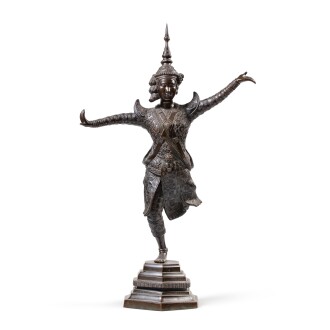T he Indochine Sale brings together nearly 50 exceptional works from the golden age of 20th-century modern Vietnamese art and its successors. The Sale includes paintings, lacquers, sculptures and artifacts ranging from the 1930’s, with the first graduates of the École des Beaux-Arts d'Indochine (Indochina School of Fine Arts), into the present day. Thus, providing a wonderful insight into the evolution of modern Vietnamese art.

The Indochina School of Fine Arts
The artists of the Indochina School of Fine Arts incorporated and reinterpreted European techniques and mediums and then gradually began to break away from the Western style to forge their own artistic vocabulary, while relying on their traditional artistic techniques. This new vision transformed their compositions into beautiful portraits and scenes of contemporary Vietnam, as well as subtle reinterpretations of Asian motifs.
The school also had a small number of female students including Le Thi Luu, who was one of the few to pursue a professional career. In the early 1940s, she moved to Paris with other former students who would become established artists: Mai Trung Thu, Le Pho and Vu Cao Dam. Several members of this quartet are present in the sale: Le Thi Luu with her favorite theme, a Mother and Child, circa 1960, Le Pho with three lithographs including a delicate scene between a mother and her son and Vu Cao Dam with in particular a beautiful oil on canvas from 1979 representing a Poet.

Le Thi Luu
The Vietnamese-born painter Lê Thị Lựu was one of the first female students at the Ecole des Beaux-Arts d’Indochine and the first Vietnamese woman to pursue a professional career as an artist. In her time, the country still bore heavy traces of the cultural heritage of Confucianism: young girls were expected to be obedient and to grow up to be devoted wives and good mothers. Born into a traditional family, wife of a nationalist politician, and a bohemian artist in Paris, Le Thi Luu was a fascinating multi-faceted artist.
Born in 1911 in Tho Khoi, Northern Vietnam, and at the age of 14 – against all odds – she decided to become a painter. She began preparing the entrance exam for the École des Beaux-arts de l’Indochine, and was admitted in 1927 at the age of just 16. Once she graduated, she taught painting for seven years at the École des arts appliqués de Gia Dinh, then at the Lycée du Protectorat in Hanoi until 1939.
In the early 1940s, Lê Thị Lựu came to France with her husband, Ngô Thê Tân, as did fellow Vietnamese artists Mai Thứ, Lê Phổ and Vũ Cao Đàm.
In the 1950s, Lê Thị Lựu immersed herself in her Vietnamese cultural origins, principally painting with ink and gouache on silk. Her favourite themes were Vietnamese women and children, whose radiant faces she portrayed in a particularly realistic way, in a striking contrast with works by her painter friends such as Lê Phổ and Mai Trung Thứ. Her ingenious colour combinations, carefully rendered light, and delicate, sensitive brushstrokes bring us into an idealised world tinged with elegance, serenity and softness.
The mother carries her child in her arms, and her face glows with warm motherly love. Both are dressed and groomed in traditional Vietnamese fashion, and the mother wears a beautiful white silk dress áo dài. The mother and child are central to the composition, bathed in light and adorned with bouquets of flowers. This touching, intimist painting on silk is emblematic of the work of Lê Thị Lựu, suffused with the devoted love between mother and child.
Read LessEST 60,000–80,000 EUR

Lacquer
Lacquer work is one of the oldest forms of craftsmanship in Asia, and it is a medium that is difficult to master. In the 1930s, Joseph Inguimberty, a professor at the École des Beaux-Arts d’Indochine, opened a lacquer workshop there. He encouraged his students to combine the vision of Western modern painting with Asian techniques. Lacquer work thus took on a new dimension at a time when Vietnamese art was at its golden age (1930–1945).
The piece Landscape in Northern Vietnam, (1925–1945) is not signed, which was often the case of works that were exhibited each year at the École des Beaux-Arts d’Indochine. It is either a collective work by student-artists or a composition based on the works of their mentors. This work reflects the technique and graphic design so distinctive of this movement of the 1930s to 1940s. Likewise, the colour range and use of chiaroscuro to juxtapose dark zones with bright gold may be compared with the shimmering style of works by Nguyễn Văn Tỵ, Hoàng Tích Chù, or Nguyễn Tiến Chung. These three artists, who were students at the École des Beaux-Arts d’Indochine at the time, were the principal initiators of a modern change of direction in traditional Vietnamese lacquer painting.
The unsigned work depicts a peaceful landscape in which three farmers recline in their fields near the rice fields. The lush vegetation nearly conceals a house at the foot of the mountain in the background, while the viewer’s eye is drawn to the profusion of golden leaves in the foreground. In juxtaposition with the dark, massive mountain, the delicate golden leaves, the subtle rendering of the rice fields and foliage, and the harmonious incorporation of human figures all bring a feeling of balance to the composition. The scene remains suspended in an undisturbed instant of serenity and peace that one would be reluctant to upset, transporting us to the poetic, idealized Asian unity between man and nature. Majestic and subtle, this work is a true testimonial to a perfect mastery of the lacquer technique.






















